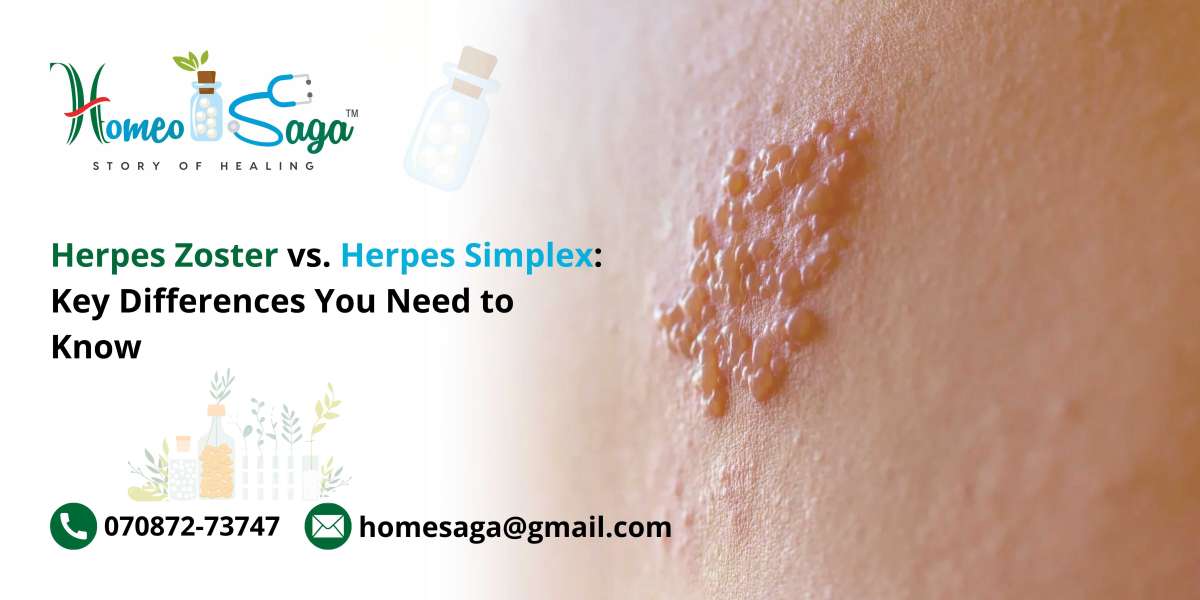When discussing viral infections, many people often confuse Herpes Zoster and Herpes Simplex. While both are caused by members of the herpesvirus family, they are distinct in their causes, symptoms, and treatment. Understanding the key differences between Herpes Zoster vs. Herpes Simplex can help you better navigate these conditions and manage their effects.
What are Herpes Zoster and Herpes Simplex?
Herpes Zoster, commonly known as shingles, is caused by the reactivation of the varicella-zoster virus (VZV), which is the same virus responsible for chickenpox. After a person recovers from chickenpox, the virus remains dormant in the nerve tissues and can reactivate later in life, particularly in individuals with weakened immune systems or older adults.
Herpes Simplex, on the other hand, refers primarily to two types of viruses: HSV-1 and HSV-2. HSV-1 is typically associated with oral herpes, which manifests as cold sores or fever blisters around the mouth. HSV-2 is primarily responsible for genital herpes, affecting the genital and anal areas. Both forms of Herpes Simplex can be transmitted through direct contact with an infected area.
Key Differences in Symptoms
One of the most noticeable distinctions in the Herpes Zoster vs. Herpes Simplex debate is their symptoms.
Herpes Zoster typically presents as a painful rash that appears on one side of the body. This rash often starts with itching or tingling sensations, followed by the development of blisters that eventually crust over. The pain associated with shingles can be severe and is often described as burning or throbbing. It may also be accompanied by flu-like symptoms, such as fever and fatigue.
In contrast, Herpes Simplex symptoms vary based on the type. For HSV-1, the symptoms usually include sores around the mouth and lips, while HSV-2 often results in painful sores in the genital area. Both types can cause itching, burning, and discomfort, but the lesions typically heal within a week or two.
Transmission and Contagion
The transmission of Herpes Zoster vs. Herpes Simplex also differs significantly. Herpes Zoster is not spread through casual contact. Instead, it can only be transmitted through direct contact with the fluid from the blisters of someone who has an active shingles outbreak. Importantly, a person who has not had chickenpox can contract chickenpox from someone with shingles, but not shingles itself.
Herpes Simplex is highly contagious and can be transmitted even when sores are not present. HSV-1 can be spread through kissing or sharing utensils, while HSV-2 is primarily transmitted through sexual contact. Understanding these transmission methods is vital for preventing the spread of both conditions.
Treatment Options
When it comes to treatment, there are also distinct approaches for Herpes Zoster vs. Herpes Simplex.
For Herpes Zoster, antiviral medications such as acyclovir, valacyclovir, or famciclovir can help reduce the severity and duration of the outbreak. Pain management strategies, including over-the-counter pain relievers and topical treatments, are also important components of care. In some cases, corticosteroids may be prescribed to reduce inflammation and pain.
For Herpes Simplex, antiviral medications are similarly effective. Acyclovir, valacyclovir, and famciclovir can help manage outbreaks and reduce the risk of transmission. Additionally, topical treatments and lifestyle changes, such as stress management, can help prevent flare-ups.
Prevention Strategies
Prevention strategies differ for each condition as well. A shingles vaccine is available and recommended for older adults to reduce the risk of developing Herpes Zoster. This vaccine can significantly lower the likelihood of shingles and its associated complications.
For Herpes Simplex, prevention focuses on safe practices, such as using condoms and avoiding intimate contact during outbreaks. Educating oneself about the signs and symptoms can also empower individuals to manage their health proactively.
Conclusion
In summary, understanding the key differences between Herpes Zoster vs. Herpes Simplex is essential for effective management and prevention. Both conditions, while caused by herpesviruses, have unique characteristics that warrant attention. If you suspect you have either condition, it’s crucial to consult a healthcare professional for accurate diagnosis and appropriate treatment. By staying informed, you can take proactive steps to protect your health and well-being.








